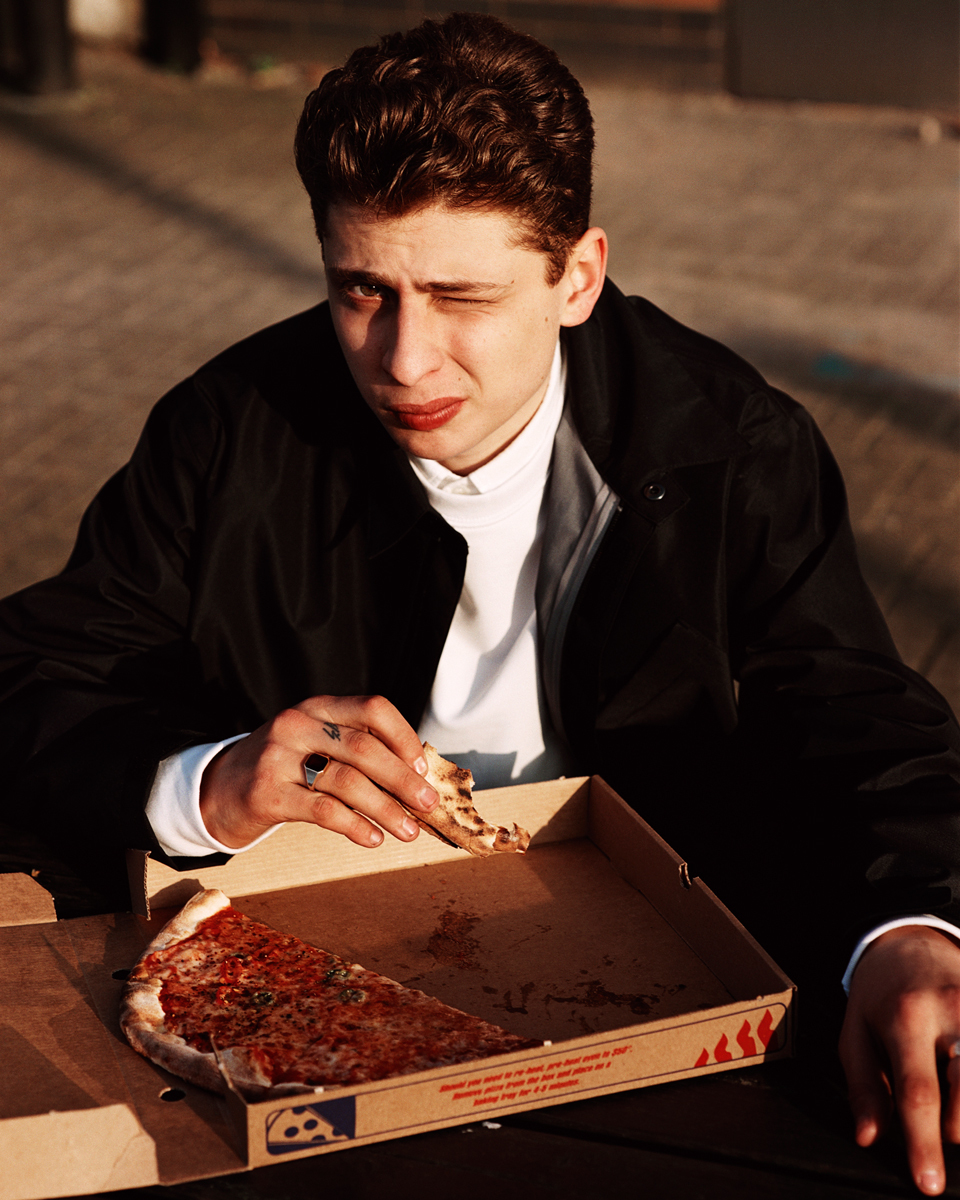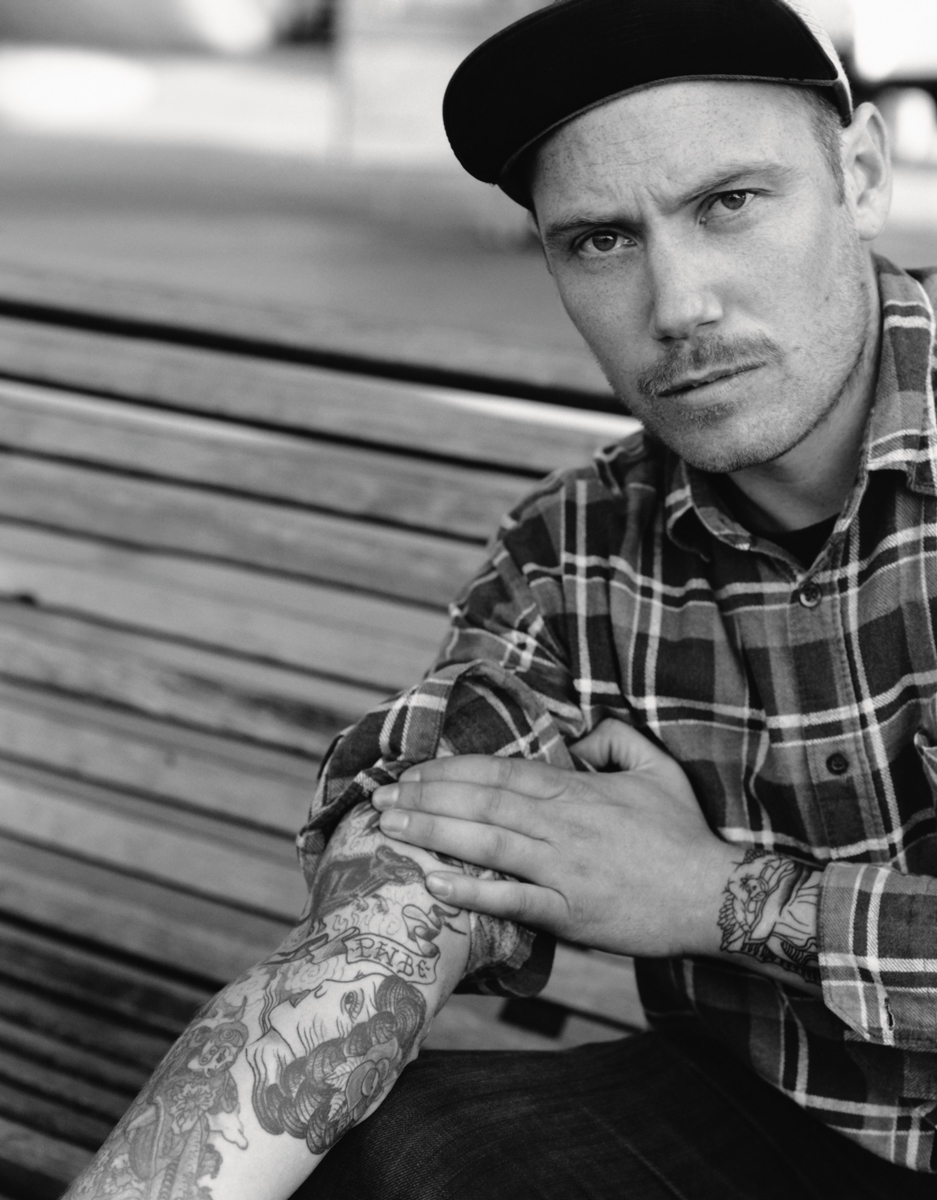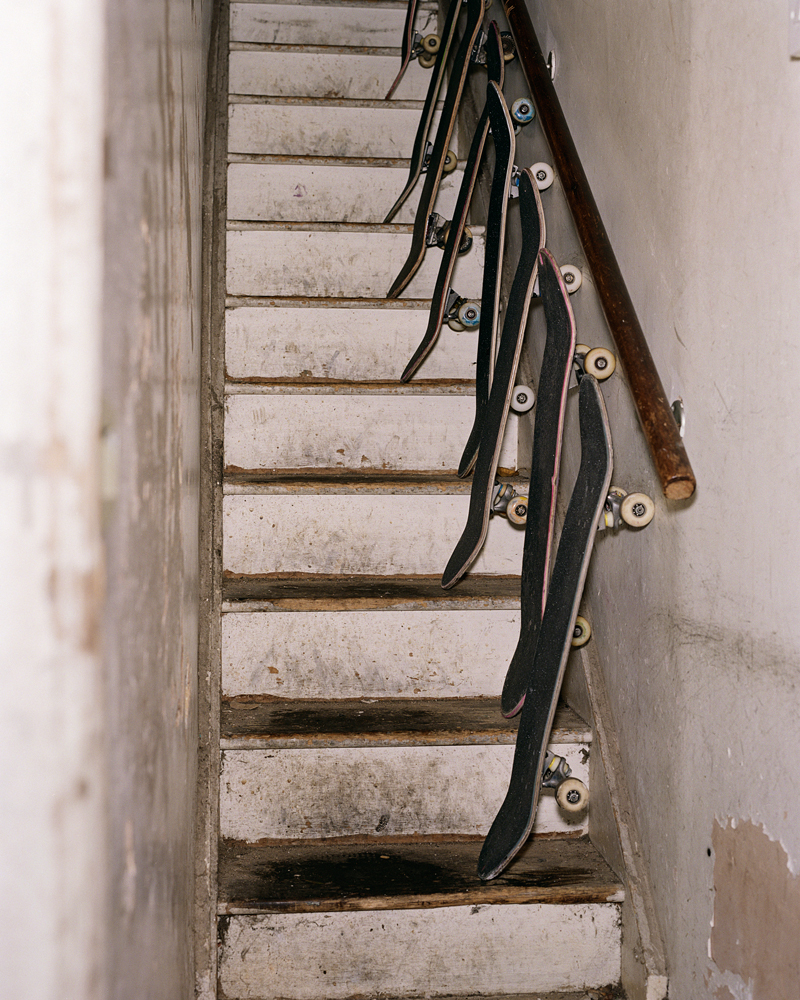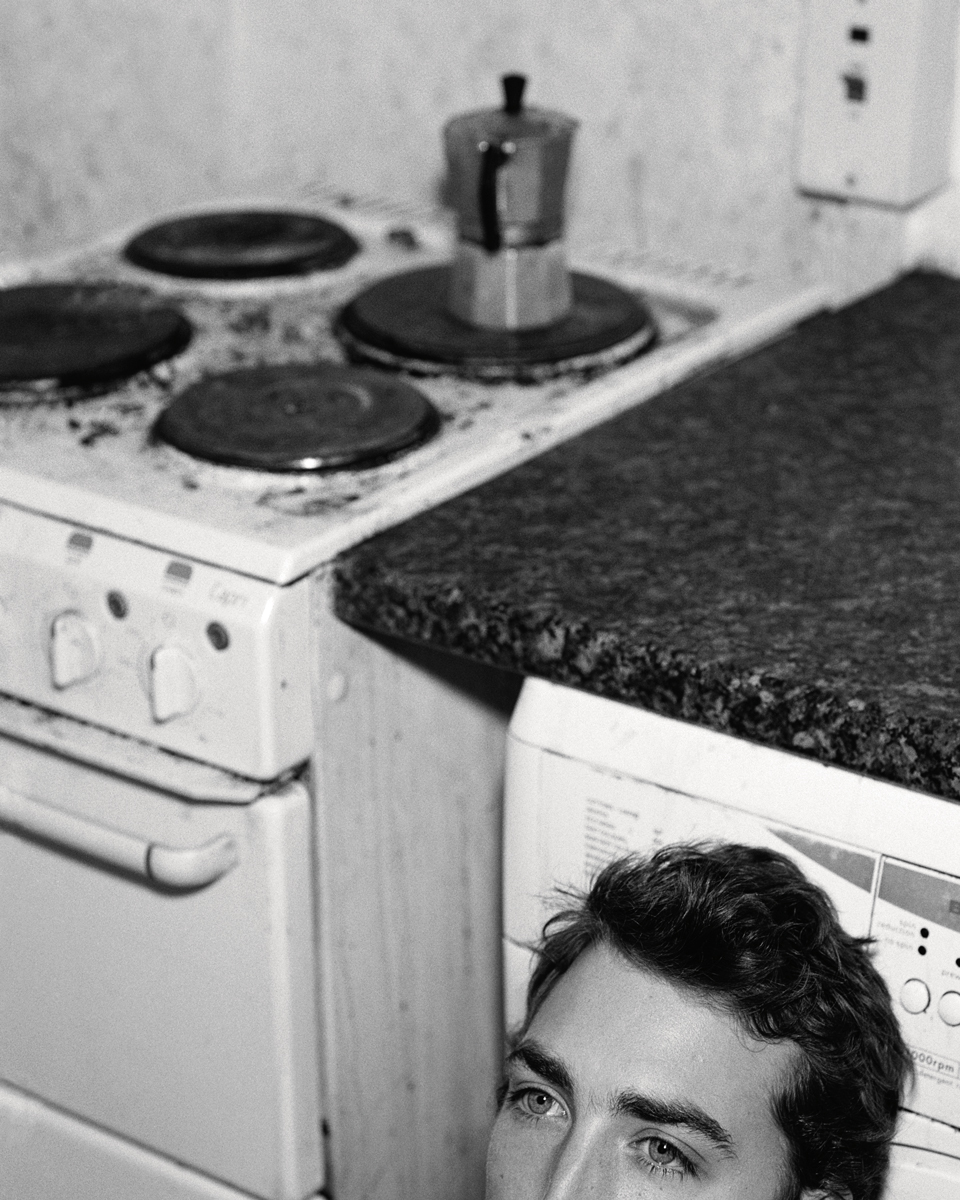


Blondey McCoy, 2016.

We were mates straight away,” Lev Tanju, founder of Palace, says about the first time he met photographer Alasdair McLellan. Alasdair and Lev were working on a London skate shoot together when Lev’s gang of mates, the Palace Wayward Boys Choir, rolled into view. For Alasdair, they immediately became the story: this Dickensian gaggle of charming characters with funny names who all lived in a dilapidated death trap of a house in Waterloo they’d ironically dubbed The Palace.
The rent at The Palace was basically nothing, so Lev and the PWBC were free to spend their days skating around London’s South Bank, making videos and t-shirts. It was a world away from the glam, sun kissed, easy riders of American skate culture. PWBC’s videos were gritty, grotty, lo-fi, and funny. Shot on VHS and camera phones, they bubbled with the camaraderie that can only be created from spending beer soaked and weed smoked afternoons hanging around the Undercroft. They transformed the outsider edge of skateboarding into something so distinctly British that it made you wonder why it had never been done before.
As a photographer whose aesthetic has captured a romantic vision of British working class life, that’s light, beautiful, nostalgic, and inimitably human, The Palace Wayward Boys Choir instantly arrested Alasdair’s imagination and he set about documenting them. Alasdair had never been interested in skaters before he met Palace, but in them he found a story that was bigger than just a skate thing — it was a cultural touchstone, a document of time, place and lifestyle.
From the dilapidated rooms of The Palace, Lev has built an empire that spans not just skate kids, but the fashion world — not just London, but the world, and Alasdair has been there, on and off, documenting its rise. From parties at The Palace, to homemade tattoos, grazed knees, and sunny skate-filled afternoons, his photographs track the brand’s stratospheric ascent.
Finally, after 10 years, Lev moved out of The Palace last year, and the landlords kicked everyone else out to redevelop a piece of prime Zone 1 real estate, ending an era of south London history in the process. It seemed a fitting time for Alasdair and Lev to work together on a book with IDEA, affectionately titled The Palace, charting their on-going fruitful creative relationship and the amazing cast of characters behind the brand. We caught up with Lev and Alasdair over a cup of tea to find out more.
When you first met, could you tell it was going to blossom into such a long and fruitful relationship?
Al: When we first met, Lev told me he wanted to start a skate brand, but so far he had only made t-shirts. What attracted me to Palace was that I always think of skating as quite American, but Palace was so English. It was so different to anything that had been around before. The way they dressed was very British: it was a casuals’ thing, a soccer terraces thing. The PWBC guys dressed like sports casuals; they didn’t dress like skaters at all.
You both represent very different elements of a British working class aesthetic, the north, and the south.
Al: In a way, yeah. No offense to Lev and his southern friends though, but all the best casuals are from the north. When I speak to Nugget [one of Palace’s designers], however young he is, he likes a lot of same things as me, like The Smiths, Cocteau Twins. We’re into the same music and the same clothes. They understand where I’m coming from as much as I understand where they come from. I feel like Morrissey could’ve invented PWBC. When I first came across them, it felt like that documentary set in 50s south London, We Are The Lambeth Boys. If they remade that documentary today, this is what it’d look like. That documentary is really lovely and charming, but this is the modern version.
Lev, when you launched Palace, did you want to create something that felt very British?
Lev: Yeah. No one was making anything that I wanted to buy, that’s when I realized I wanted to make my own stuff. Everyone was copying formulas from American skate companies, so I was like, I really want to do something that feels English, but it wasn’t a decision to make this kind of stuff, cos we were always gonna make it like this.
Had you ever photographed skaters before you met Palace, Al?
Al: Skating never happened in Yorkshire when I was growing up. My photography was always so English, I’ve never been that interested in skating because it was so derivative of American culture. That was until I met Lev and PWBC. They all looked really good, like something you’d see in Oliver Twist! It was Dickensian, these kids hanging around this house and skate park in Waterloo.
Lev: A lot of photographers start taking photos of skateboarders because they think it’s cool, but with Al, it was more like he was interested in everything outside of the actual skating.
Al: That’s because I’m not a skater. I just liked the way you all looked, I liked that your names made you sound like you were out of Brighton Rock — Nugget, Blondey, Edson, Snowy. It was an incredible thing to be able to document.
You’ve been shooting Palace since the start. How has it changed and evolved in that time?
Al: Palace is really successful now, but essentially it hasn’t changed at all. Its grown into exactly what Lev wanted it to be, but everyone behind the brand is exactly the same. There’s something about that group of people. They’re all really lovely, you can’t help but be charmed by them. I always knew Palace would be successful. There’s nothing like it, nothing with that British point of view, that British style…
Lev: I remember saying to Alasdair over a cup of tea, just after we’d met, “I wanna make a skate company that makes really nice, quality clothes, nothing too smart, just clothes you can wear.” That’s how it happened. I’m lucky that people have accepted Palace. I think that’s cos it’s honest, we’re not lying.
Palace has transcended beyond being just a skate brand, and today you see people all over the world wearing it.
Lev: It’s mad! Skating’s cool, though innit. Every ten years everyone thinks skating is cool. Then it drops off again, and people start wearing something else when that becomes cool. It changes all the time. It’s nice that people accepted it, but I’m aware that people get bored of things really quickly. But, at the end of the day, we’re doing it for our mates, so whatever happens we’ll always have that.
Does Palace still feel like a family?
Lev: Yeah, 100%. Nugget works for us now. I met him hanging around the Southbank when he was 12, and now he’s one of our head designers. It’s mental, because, like me, he has no training, but Palace is family, we are all brothers and sisters. It’s really natural.
Why did you decide to make a book together now?
Al: It just made sense. The landlord wanted to sell The Palace — the house in Waterloo that they all used to live in — so they had to move out. It’s not really a book about Palace, the brand, but about PWBC.
Lev: It’s way cooler than doing a book that’s like “Look at the first t-shirt we made.”
Al: Yeah, it’s not about the clothing line, it’s more about this idea of the gang, and how the brand grew out of that. It’s like a family photo album. And it timed perfectly with the house getting knocked down. It felt like the end of an era. It’s a very honest and charming document. It captures what Palace is about. Most brands don’t have a history like theirs, born out of hanging out on the Southbank.
How did you feel moving out of the house, Lev?
Lev: It was weird. I got a bit emo about it on the last day. I was going through everything, packing up, looking through my records, having flashbacks to all the amazing parties we’d had, all the great times we’d spent hanging out. The landlord is selling The Palace now, but that’s ok. We had to move out else it would’ve been like, what’s that show called, with those two guys who live together?
Men Behaving Badly?
Lev: Yeah! It was getting a bit like that, you know. Sometimes its good for something to just fucking end, rather than dragging it out. It was wicked, but now it’s finished.
So in many ways the book is the perfect ending to the house.
Lev: Yeah, I think so. I hope everyone else sees it like that. The skaters, PWBC, all them lot… I hope they see it as a wicked little story documenting everything that was going on at the time: a nice personal thing.
Al: I don’t like doing anything that’s not personal. As a photographer you choose your subjects because you feel a connection to them. That’s why I was never interested in skating until I met Lev, because I don’t think there’s been anything like Palace before.
Lev: It’s weird, because the house is the reason why the brand exists. We had the opportunity to do all these things, because we weren’t paying any rent. We were free to skate everyday. That’s why it was so important to take photos of the house and document it because the house made it all happen. It’s key innit, because I wouldn’t be doing this if I had to pay more than 150 quid in rent for ten years. I didn’t need to have a job. Living in The Palace meant I could go skate everyday, sit about and make videos and t-shirts.
Al: The Palace is where it all stems from.
The Palace will be published by IDEA this Summer. A selection of the images will be on display at The ICA from July 8.
Credits
Text Felix Petty
Photography Alasdair McLellan
